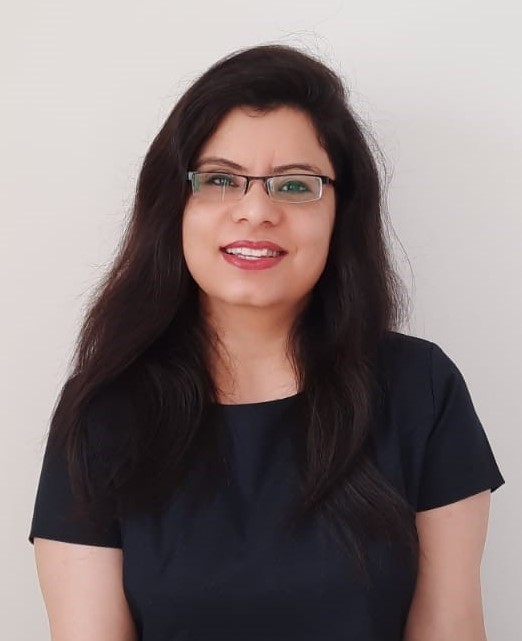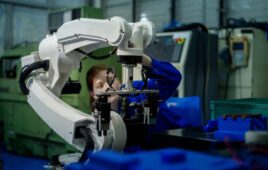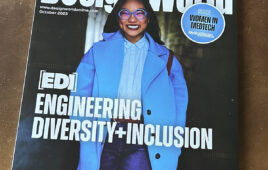Jaya Bindra, Director of Applications Engineering, IoT, Compute and Wireless Division, Infineon Technologies
Executive General Management (MBA)
Indian Institute of Management – Bangalore, India
Bachelor of Technology in Electronics and
Communication – Kurukshetra University, India

Jaya Bindra is Director of Applications Engineering, IoT, Compute and Wireless Division, Infineon Technologies. She loves to mentor teams and enable their creativity to build innovative solutions that make life easier, safer and greener. Jaya takes great pride in leading the Applications and Solutions Development group at Infineon in India.
In Jaya’s own words, “My team encourages me to be a better version of myself by putting their trust in me as a leader, and I ensure I live up to their expectation by introducing learning opportunities and working hard towards developing their career.”
During her school years, Jaya was a national level gymnast and even today indulges in casual somersaults. She believes in simple and innovative solutions to problems. She is passionate about technology and has authored more than 45 technical write-ups in international magazines related to IoT and embedded systems. Jaya is also a column owner in an online magazine called Embedded-Computing.com.
Talk about the culture at your company. What makes it inclusive or supportive of women in engineering and automation?
Infineon is a unique company that provides ownership of impactful and challenging projects to employees at all levels The company also guides them to the finish line, which is something I appreciate. Infineon inspires me to embrace innovation and continue to work towards creating a new, better version of myself.
Describe a recent company project (in which you were involved) that went particularly well. How did you and your team go about ensuring success?
In October 2021, our fairly new team of two, were approached to deliver a proof-of-concept for a demo that runs a completely new, state-of-the-art technology called ‘Matter’ using Infineon products. Our deadline was short, only two months to architect, design, build hardware, firmware and a mobile App to present the demo. The project was very complex as it included integrating different Infineon products such as PSoC™ 6 MCU, PSoC™4 MCU, AIROC™ WiFi/Bluetooth devices, OPTIGA™ Trust M, to make a full-fledged smart lock design.
We took this project up as a challenge, and while our team was architecting and learning the new technology, we also collaborated with design partners to support the development. We were able to secure a partner, and our two-month journey began. We trained our partner while working on the design. Eventually, this partner acted like our extended team for Hardware, Firmware and App development and we were able to deliver the solution one week before our deadline.
The notable achievement is the final demo looked more like a reference platform than a proof-of-concept, and the same demo became Infineon’s flagship demo for ‘Matter’ at various events thereafter including CSA (who define Matter spec) and Embedded world events. We believed in our capabilities and trusted our instincts, and that worked to the team’s advantage.
What first drew you to engineering and this industry?
Interest and curiosity initially drew me into engineering. Things like resistors, capacitors, and lights fascinated me. When it came to studying engineering, I knew from the get-go it would be Electronics Engineering. A good engineer requires one to be a creative problem-solver.
As engineers, we make the unsatisfactory – satisfactory; we make things work. And I have always enjoyed design and building things, resulting in greater job satisfaction, and keeping me engaged and interested. What I enjoy most is helping customers solve their interesting and complex issues using the right technology, products and software.
Describe your biggest career challenge. How did you solve it — or what was the outcome or lesson learned?
Change is the one thing that is constant in life, which helps you evolve and grow. As a leader, my biggest challenge has been to get people to recognize that change is needed to support competitive and innovative semiconductor trends. Most people fear change, they don’t want to experience the discomfort of giving up their comfort zone. So, the recurring challenge I have faced has been to deal with the resistance to embracing new ideas and systems.
One thing I have learned is that words and communication make all the difference. For instance, rather than using the word “change,” I use the word “transition.” This means we are going to take what has been good and make it better. And, this small change of one word has actually helped more people accept new ideas and systems in the teams I manage.
What career advice would you give to your younger self?
Do not try to fit in. You are meant to stand out, and you are meant to be a smart person. You are capable of figuring out and learning just about anything. Don’t sell yourself short. I’ve learned the 3 essentials are discipline, ability to break challenges into manageable tasks, and no fear of failure. Great learnings sprout from failures and eventually contribute to your overall success.
Filed Under: Engineering Diversity & Inclusion




